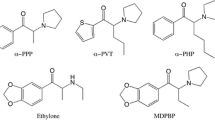Abstract
Seroquel was compared to clozapine and several other antipsychotic agents in tests predictive of antipsychotic activity or extrapyramidal symptoms. In the conditioned avoidance test in squirrel monkeys as well as several paradigms using apomorphine or amphetamine-induced behavioral alterations, seroquel displayed the profile of a drug with potential antipsychotic activity. In these paradigms the potency of seroquel was somewhat less than clozapine in rodent tests, while the reverse was true in higher species, i.e. monkeys, cats. In tests designed to evaluate the propensity to induce EPS or tardive dyskinesia, for example, the production of dyskinetic reactions in haloperidol-sensitized cebus monkeys, seroquel displayed a profile similar to clozapine and disparate from typical antipsychotic drugs. In drug-naive cebus monkeys seroquel sensitized significantly fewer monkeys than haloperidol and the dyskinetic reactions were of significantly less intensity. It is anticipated that this novel antipsychotic agent will have a significantly reduced propensity to produce extrapyramidal symptoms and tardive dyskinesia than typical antipsychotics.
Similar content being viewed by others
References
Anger B, Reichert S, Heimpel H (1987) Clozapine-induced agranulocytosis. Blut 55:63–64
Barany S, Gunne LM (1979) Pharmacological modification of experimental tardive dyskinesia. Acta Pharmacol Toxicol 45[2]:107–111
Barany S, Haggstrom JE, Gunne LM (1983) Application of a primate model for tardive dyskinesia. Acta Pharmacol Toxicol (Copenh.) 52[2]:87–89
Bigelow LB, Nasrallah H, Carman J, Gillin JC, Wyatt RJ (1977) Baclofen treatment in chronic schizophrenia: a clinical trial. Am J Psychiatty 134:318–320
Casey D (1989) Clozapine: Neuroleptic-induced EPS and tardive dyskinesia. Psychopharmacology 99:S47-S53
Claghorn J, Honigfeld G, Abuzzahab FS, Wang R, Stienbook A, Tuason V, Klerman G (1987) The risks and benefits of clozapine vs chlorpromazine. J Clin Psychopharmacol 7:377–384
Ellinwood EH, Sudilovsky A (1973) In: Cole JO, Freedman AM, Friedhoff AJ (eds) Psychopathology and Psychopharmacology. John Hopkins University Press, Baltimore, pp 51–70
Griffith RW, Saameli K (1975) Clozapine and agranulocytosis. Lancet 2:657
Kane J, Honigfeld G, Singer J, Meltzer H, and the Clozaril Collaborative Study Group (1988) Clozapine for the treatment-resistant schizophrenic: a double-blind comparison with chlorpromazine. Arch Gen Psychiatry 45:789–796
Karson C, Freed WJ, Kleinman JE, Wyatt RJ (1981) Neuroleptics decrease blinking in schizophrenic subjects. Biol Psychiatry 16:679–682
Lieberman JA, Hohn CA, Mikane J, Rai K, Pisciotta AV, Saltz BL, Howard A (1988) Clozapine-induced agranulocytosis: non-cross-reactivity with other psychotropic drugs. J Clin Psychiatry 49:271–277
Morelli M, Di Chiara G (1985) Catalepsy induced by SCH-23390 in rats. Eur J Pharmacol 117:179–186
Noggon B, Linden M, Beckmann H, Krebs E, Kufferle B, MullerOerlinghausen B, Pflug B, Schied HW (1986) The AMDP system in international clinical trials: a double-blind comparison of fluperlapine and haloperidol. Psychopharmacol Bull 22[1]:47–51
Protais P, Costentin J, Schwartz JC (1976) Climbing behavior induced by apomorphine in mice: a simple test for the study of dopamine receptors in striatum. Psychopharmacology 50:1–6
Reynolds GP, Czudek C (1988) Status of the dopaminergic system in post-mortem brain in schizophrenia. Psychopharmacol Bull 24:345–347
Shopsin B, Klein H, Aaronson M, Collora M (1979) Clozapine, chlorpromazine, and placebo in newly hospitalized, acutely schizophrenic patients: a controlled, double-blind comparison. Arch Gen Psychiatry 36:657–664
Stevens JR (1978) Eye blink and schizophrenia: psychosis or tardive dyskinesia? Am J Psychiatry 135:223–226
Tarsy D (1983) Neuroleptic-induced extrapyramidal reactions: classification, description, and diagnosis. Clin Neuropharmacol 6:S9–26
Ther L, Schramm H (1962) Apomorphin-synergismus (zwangsnagen bein mausen) als test zur differenzierung psychotroper substanzen. Arch Int Pharmacodyn 188:302–309
Warawa E, Migler B (1989) Novel dibenzothiazepine antipsychotic. US Patent number 4,879,288
Yamauchi M, Funatsu K, Nakamura J (1977) Effectiveness of baclofen in schizophrenia. Kurume Med J 24:111–116
Author information
Authors and Affiliations
Rights and permissions
About this article
Cite this article
Migler, B.M., Warawa, E.J. & Malick, J.B. Seroquel: behavioral effects in conventional and novel tests for atypical antipsychotic drug. Psychopharmacology 112, 299–307 (1993). https://doi.org/10.1007/BF02244925
Received:
Revised:
Issue Date:
DOI: https://doi.org/10.1007/BF02244925




